Catholic Cathedral of St. Vibiana (aka St. Vibiana's)
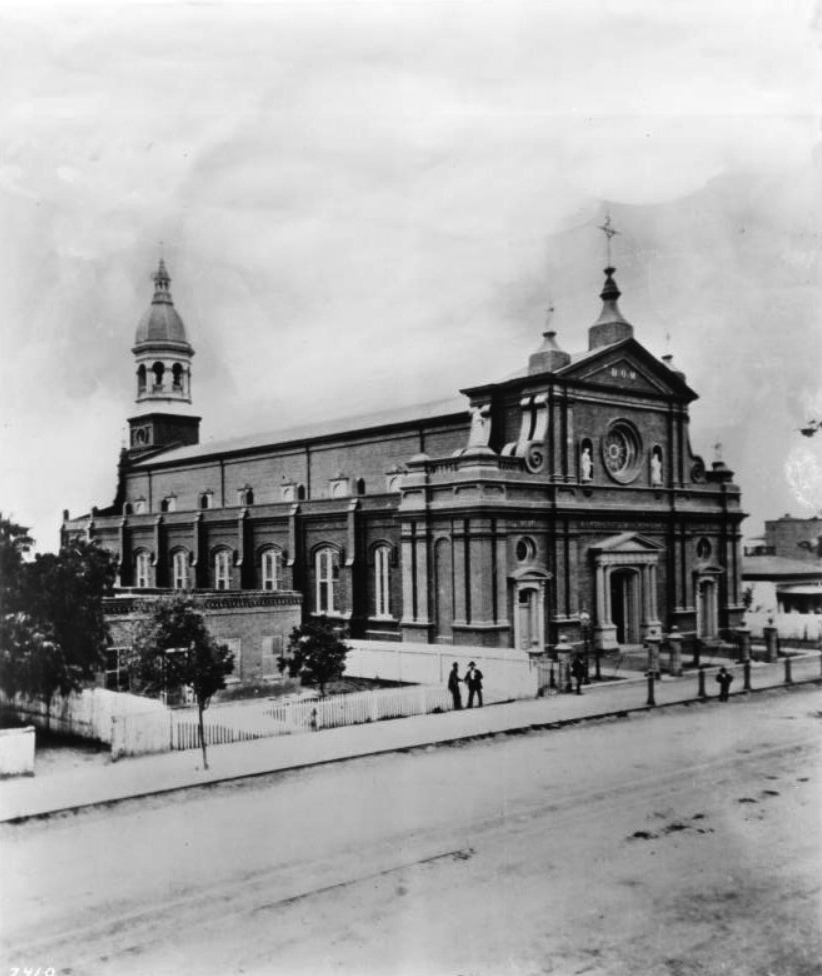 |
|
| (ca. 1880)* – View of St. Vibiana's Cathedral soon after its completion, located on the east side of Main Street south of 2nd Street. Built between 1871 and 1876, the arabesque cathedral stands at center, a rose window positioned above the main entrance with a religious statue affixed at either side. It is surrounded by a wrought-iron fence. The cathedral's bell tower can be seen extending from the back of the building. To the left, two men stand and talk in front of the Union Rescue Mission's own picket fence. |
Historical Notes Plans for a cathedral dated back to 1859; and land for the facility was donated by Amiel Cavalier. The complex, on the southeast corner of Main and Second Street in downtown Los Angeles, was dedicated in 1876 and cost $80,000 to build. The Cathedral's architect, Ezra F. Kysor, also designed the landmark Pico House.* |
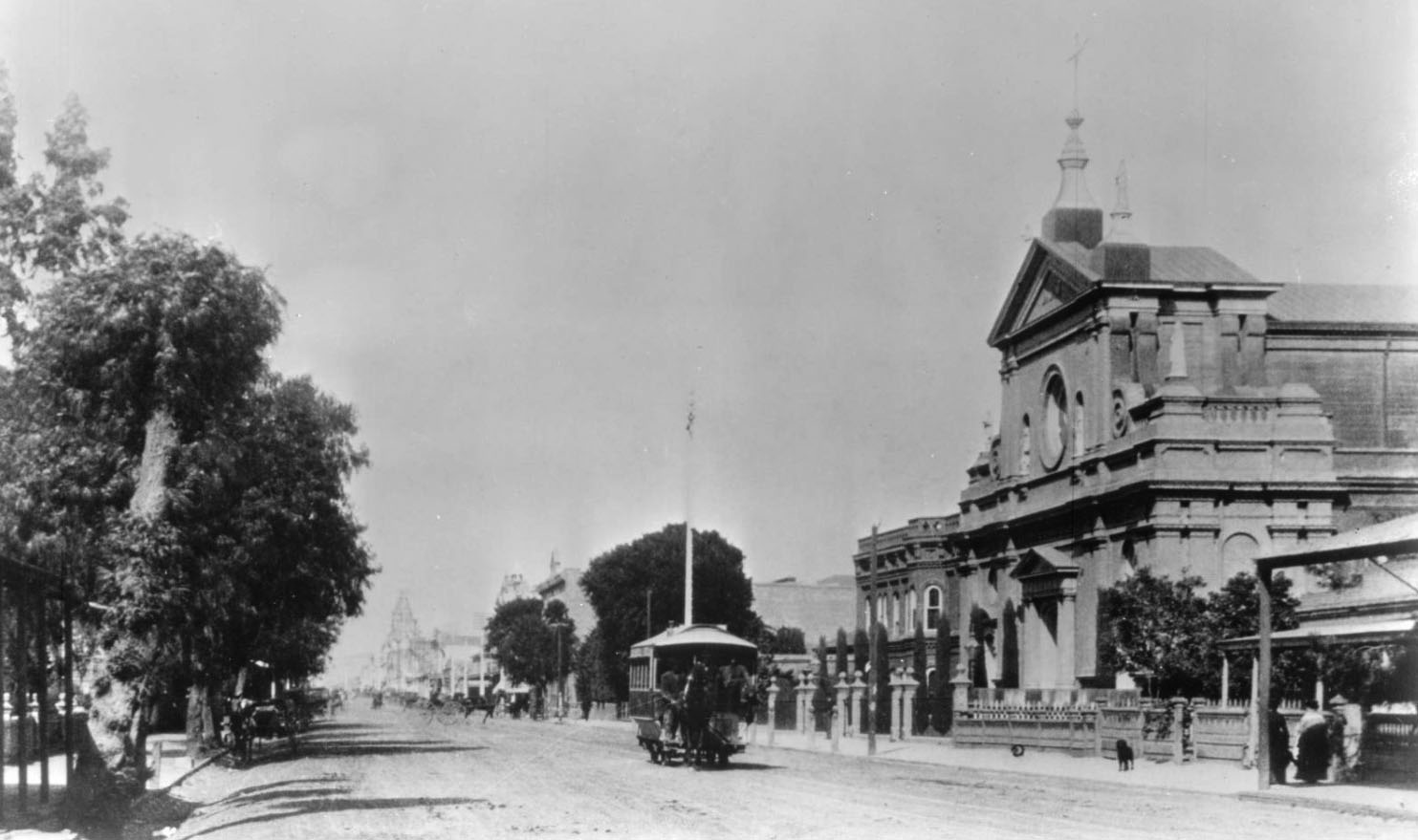 |
|
| (1884)* - Main Street looking north toward 2nd Street, showing the Cathedral of St. Vibiana on the right side. Horse-drawn streetcar can be seen heading South on Main Street. |
Historical Notes The Cathedral of Saint Vibiana, often called St. Vibiana's, was a cathedral church building and parish of the Roman Catholic Archdiocese of Los Angeles. The building opened in 1876 as the cathedral for what was then known as the Diocese of Monterey-Los Angeles, and remained the official cathedral of the Los Angeles for over 100 years.* |
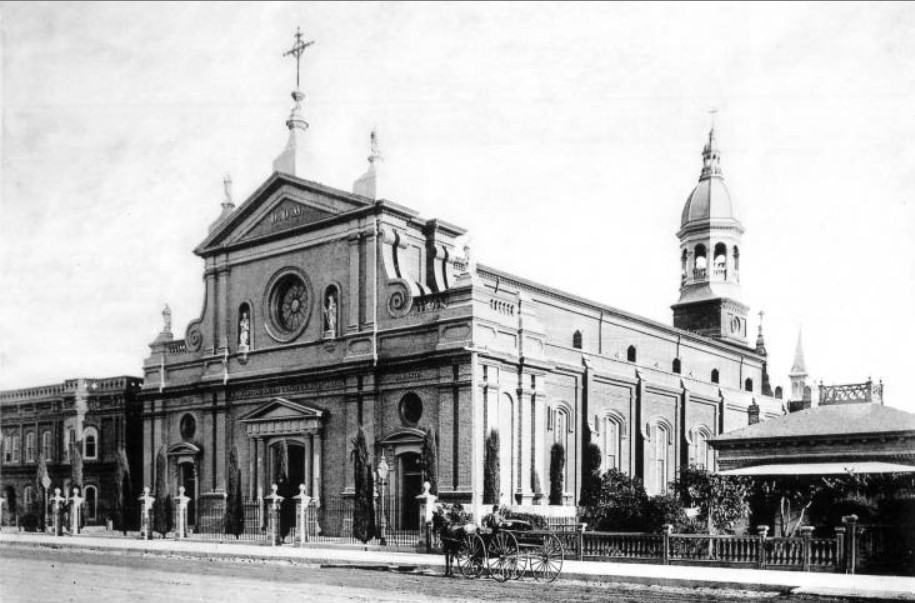 |
|
| (1885)^^* - A man stands near a horse-drawn carriage is parked on the dirt road in front of St. Vibiana's Cathedral located at 200-248 S. Main Street. |
Historical Notes Pope Pius IX chose the Cathedral's name, choosing third-century Roman martyr Saint Vibiana. Cathedrals traditionally contained the relics of a saint, so the remains of St. Vibiana were removed from the Catacombs of Rome and moved to a gilt and plate glass sarcophagus located in a niche above the high altar.* |
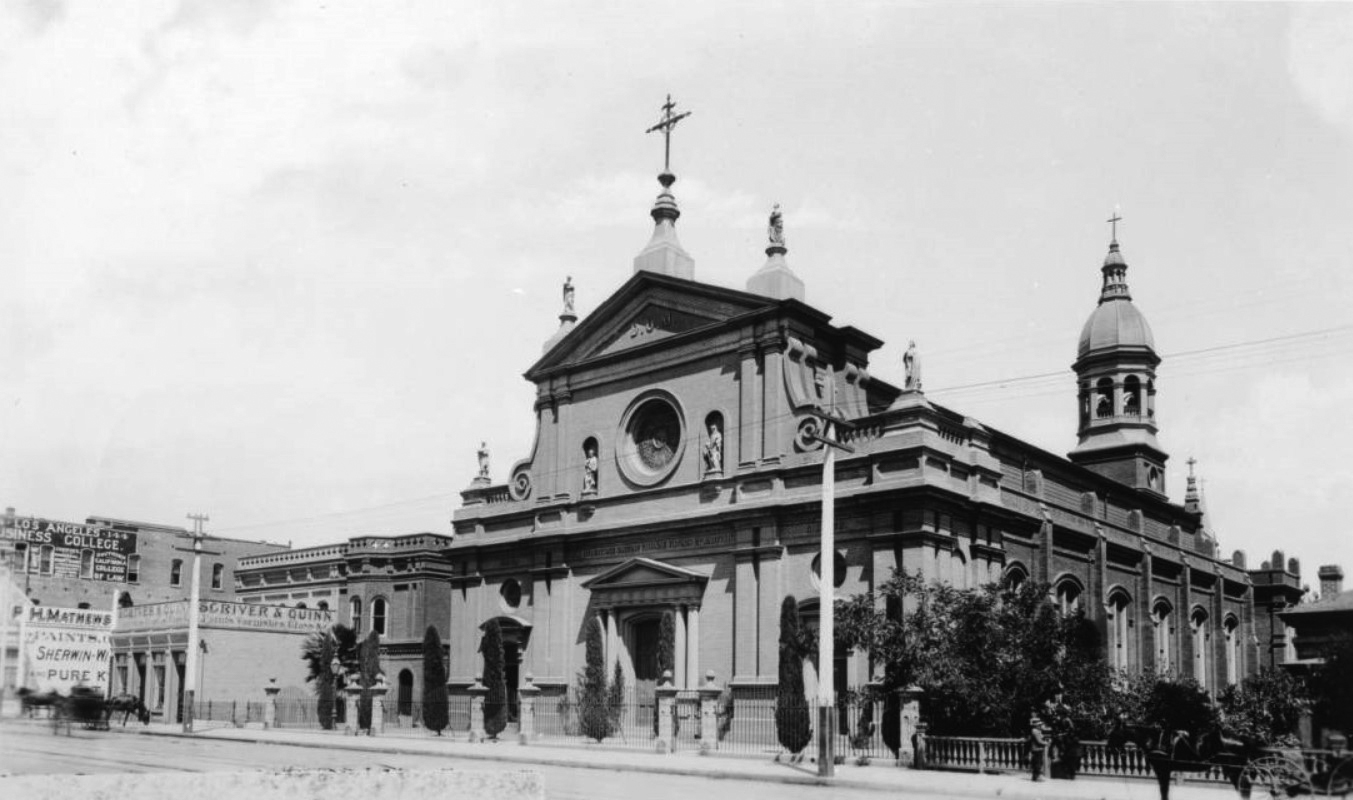 |
|
| (ca. 1888)* – View showing the Cathedral of Saint Vibiana, located near the southeast corner of Main Street and Second Street. The large, neo-Classical cathedral is shown at center, with other, commercial buildings at its left. Several statues protrude from the church's roof, along with two spired steeples. The façade shown has two unadorned pediments, a rose window, and a balustraded railing along the lower roofline. Pedestrians and horse-drawn buggies stand on the sidewalk and street in front of the cathedral. |
Historical Notes The Baroque-inspired Italianate structure was a landmark in the early days of Los Angeles. When first opened, it held one-tenth of the young town's population. |
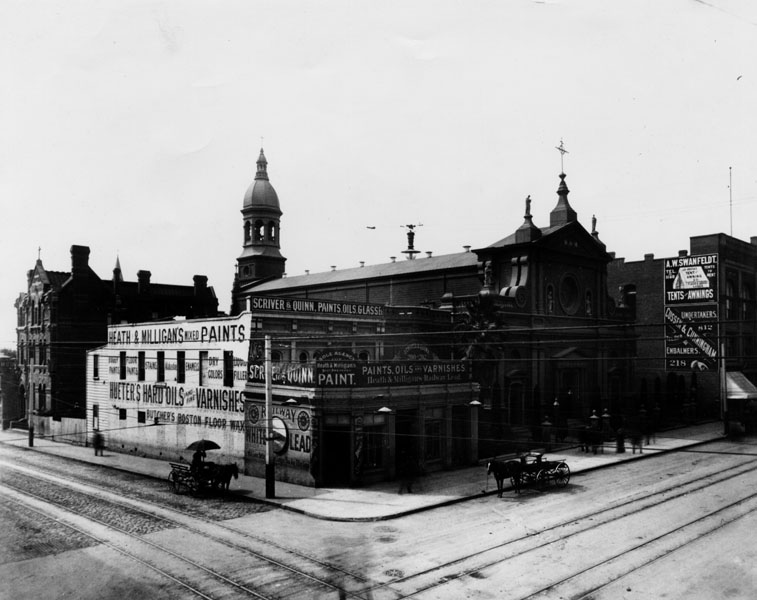 |
|
| (ca. 1890s)* - Exterior view of the Cathedral of St. Vibiana as it appeared in the late 19th century. Horse-drawn wagons are parked at the curb. Note that the corner building is now a paint store. |
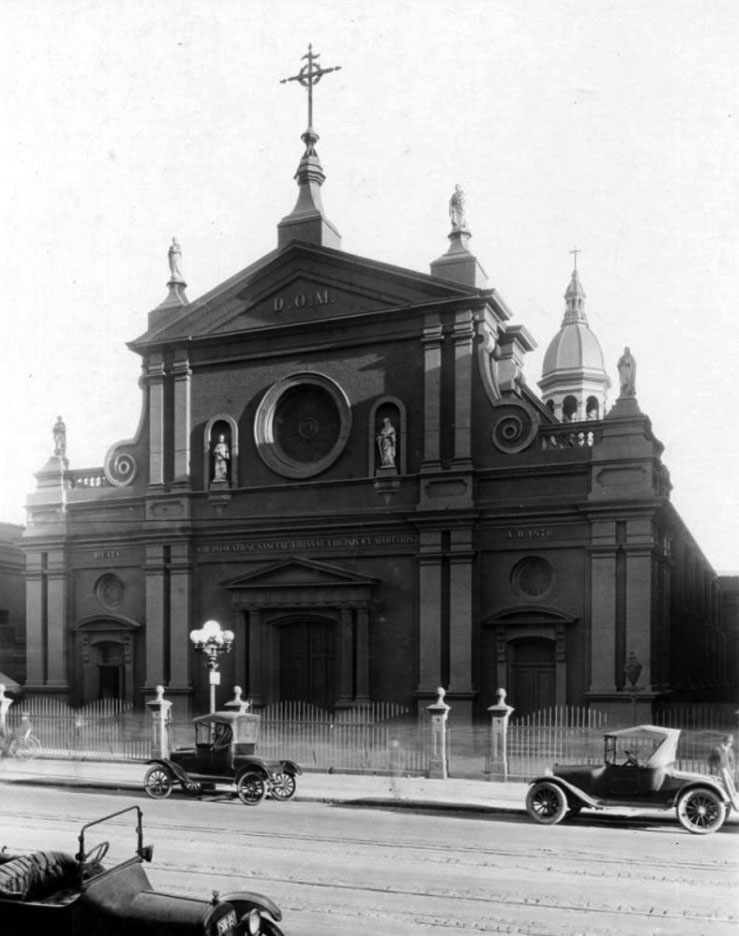 |
|
| (ca. 1920)* - Three early model cars are parked in front of the the Catholic Cathedral of St. Vibiana. |
Historical Notes The interior was remodeled around 1895, using onyx and marble; the exterior facade was changed in 1922-24 to give it its present look, said to be based on a Roman design.* |
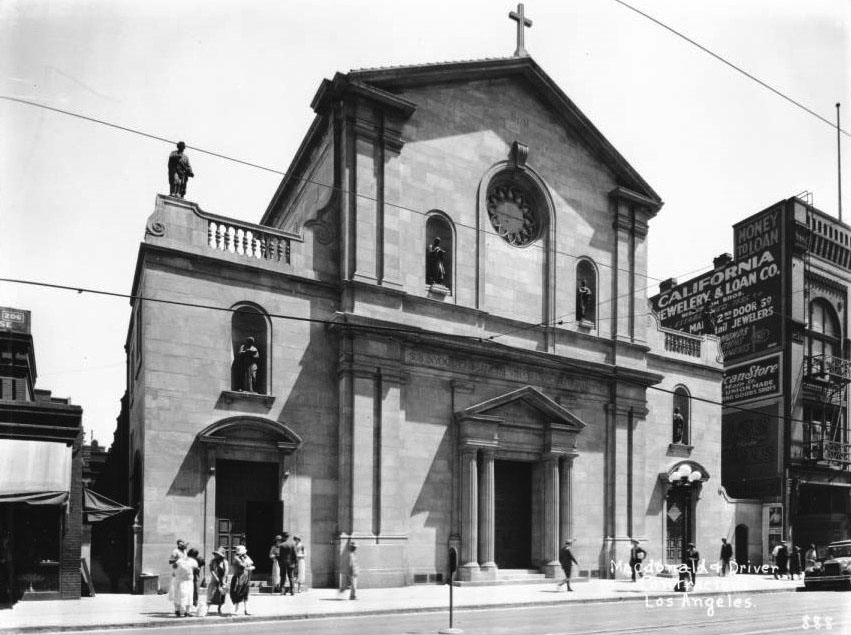 |
|
| (ca. 1930)^^* – View of Saint Vibiana's Cathedral (Saint Mary's Church), showing pedestrians in front. At center, the two-story Greek Revival-style building is pictured, it's leftmost of three doors open. In front, pedestrians stand by the open door or walk by on the sidewalk. At right, a two-story commercial or tenement building features advertisement on its side wall, reading: "California Jewelry & Loan Co", "[...]ican Store" and "Money To Loan". |
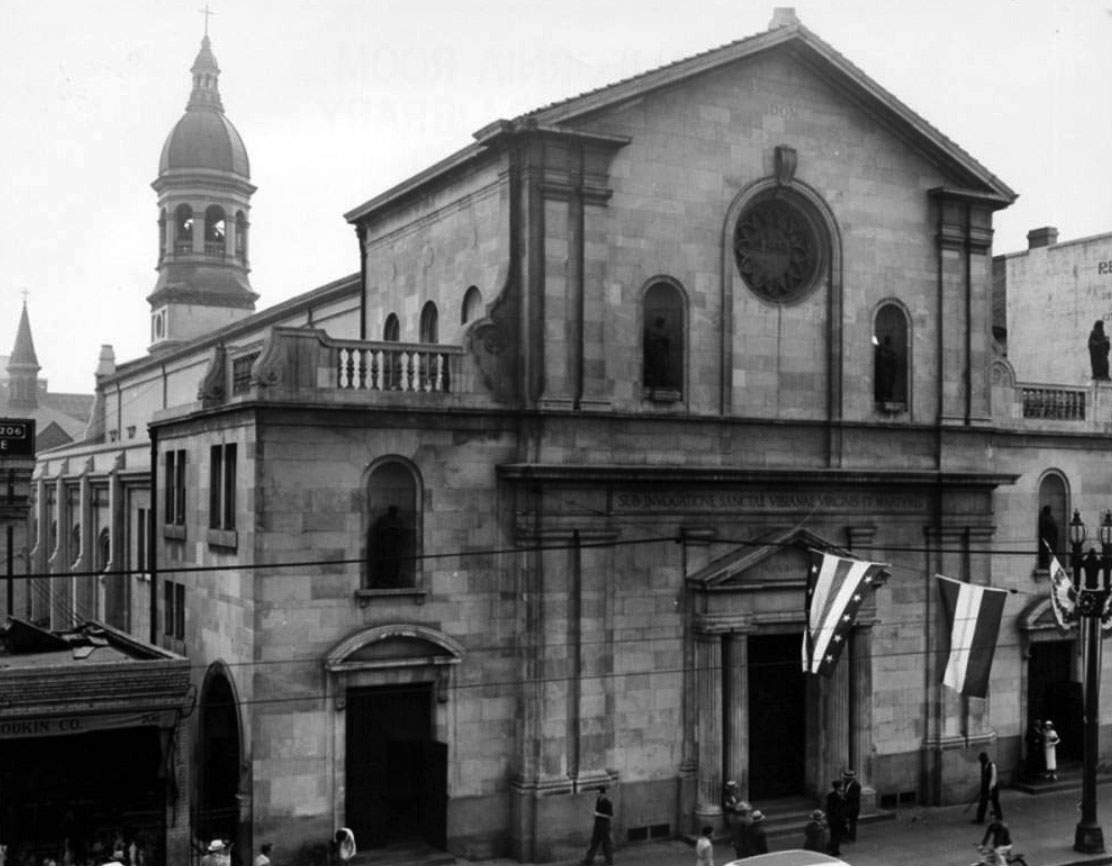 |
|
| (1939)* - Front facade of the Catholic Cathedral of St. Vibiana. Remodeled in 1922. Architect: John C. Austin. |
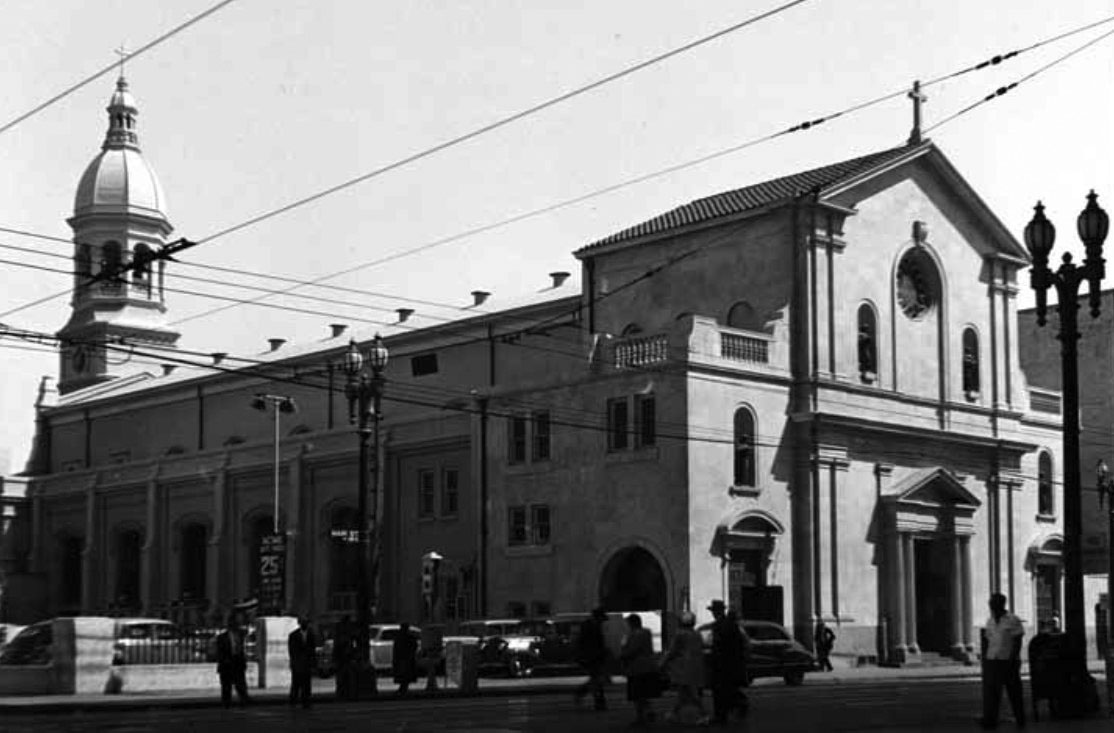 |
|
| (1947)* - Side view of St. Vibiana Cathedral at Main and 2nd Streets, showing autos and pedestrians. Note the beautiful two-lamp streetlight at right. |
Historical Notes During the 1940s, a rectory and school building were added. The school closed in 1969 because the parish could not afford it. It became a convent for the Disciples of the Divine Master.^ |
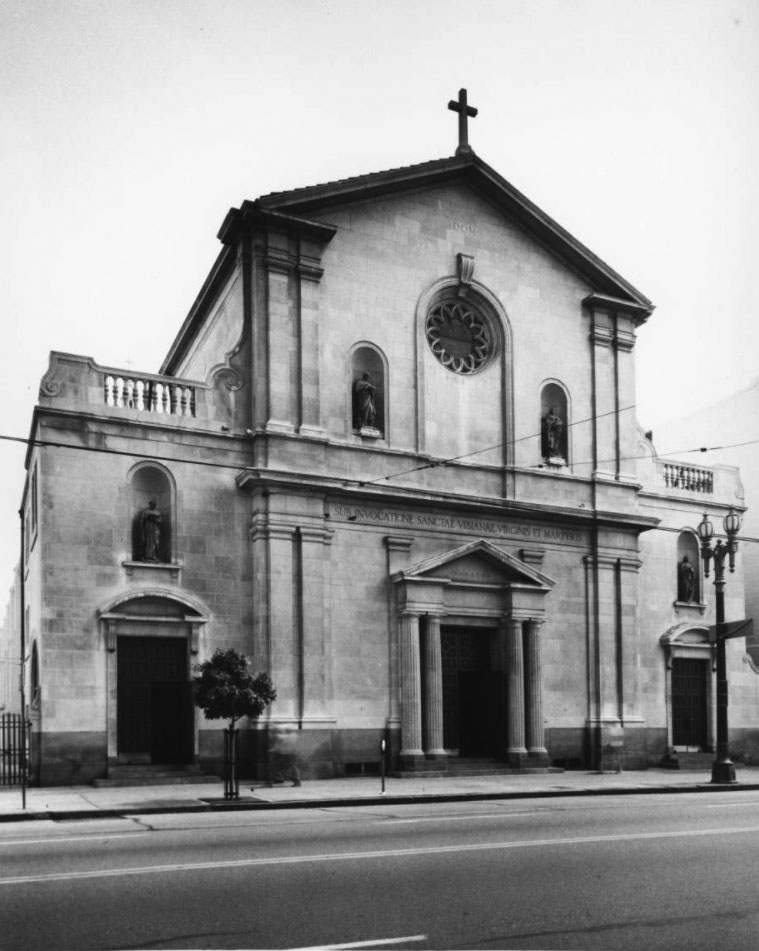 |
|
| (ca. 1950)* – Close-up view showing Saint Vibiana's Catholic Cathedral, from the Main Street side. |
Historical Notes The two-story Greek Revival-style church has three different doors visible in its facade. The centermost door is flanked by columns, while secondary doors are at left and right, each topped by a statue. Above the center, two other statues flank a rose window. A latin inscription above the center door reads: "sub invocatone sanctae vibianae virginis et martyris". |
.jpg) |
|
| (1954)* – View showing a Mass at St. Vibiana’s Cathedral as seen from the balcony. |
Historical Notes The cathedral had a seating capacity of 1,200. Designed in 1876 by Ezra F. Kysor, it was modeled after a Baroque church in Barcelona. |
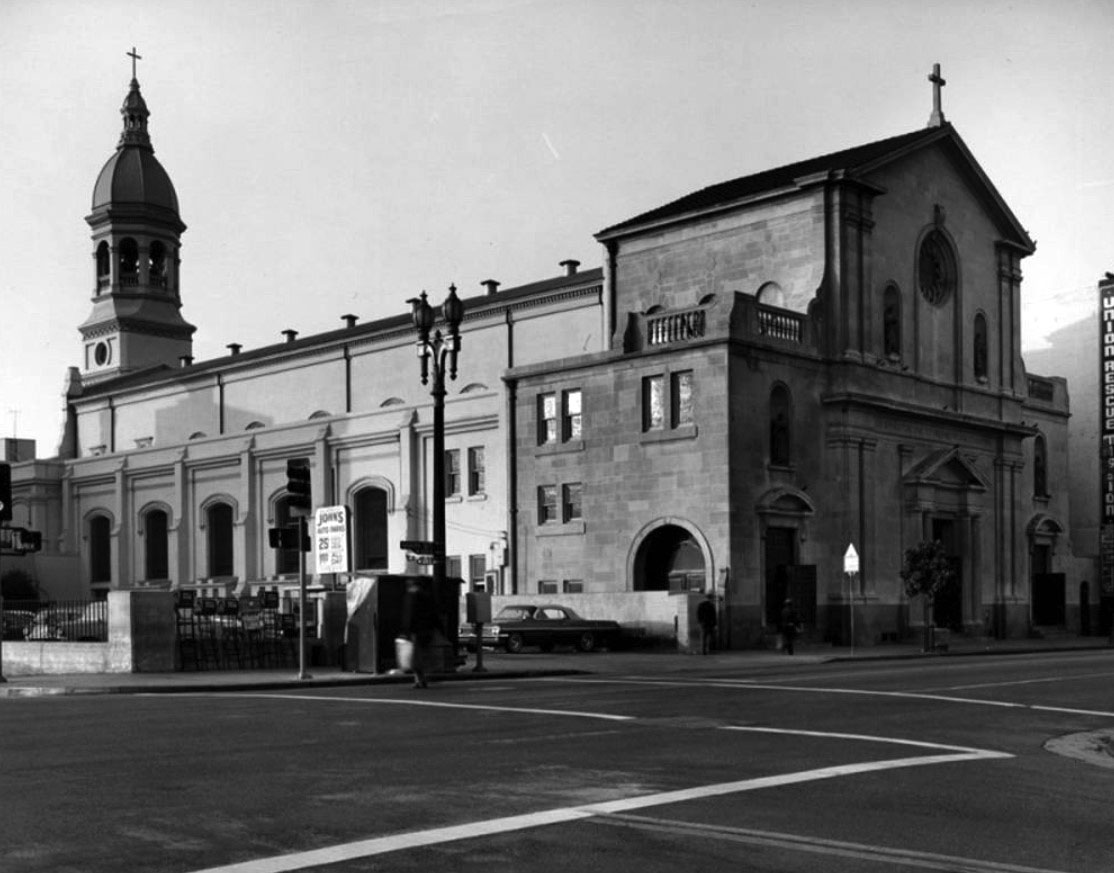 |
|
| (1955)* – View looking southeast showing the Catholic Cathedral of St. Vibiana. The sign at far right reads ‘Union Rescue Mission’. |
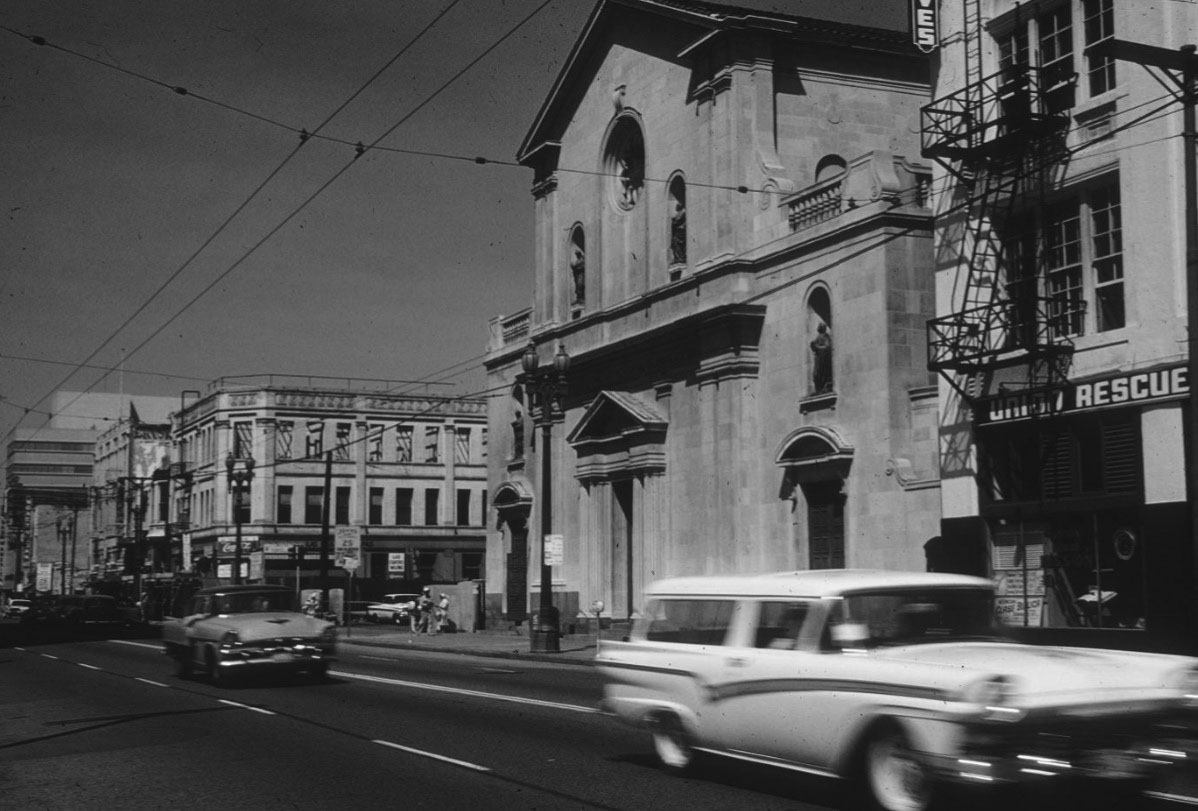 |
|
| (1960)* - Looking north on Main Street from below 2nd Street. St. Vibiana, 214 South Main Street, is at center. The Odd Fellows Hall, functioning as a rescue mission, has since been demolished. Further up Main Street, the Hotel Yorke at northeast corner, Hoegee and the 1952 City Health Building. |
Historical Notes In 1963, St. Vibiana's Cathedral was dedicated as Los Angeles Historic Cultural Monument No. 17 (Click HERE to see complete listing). |
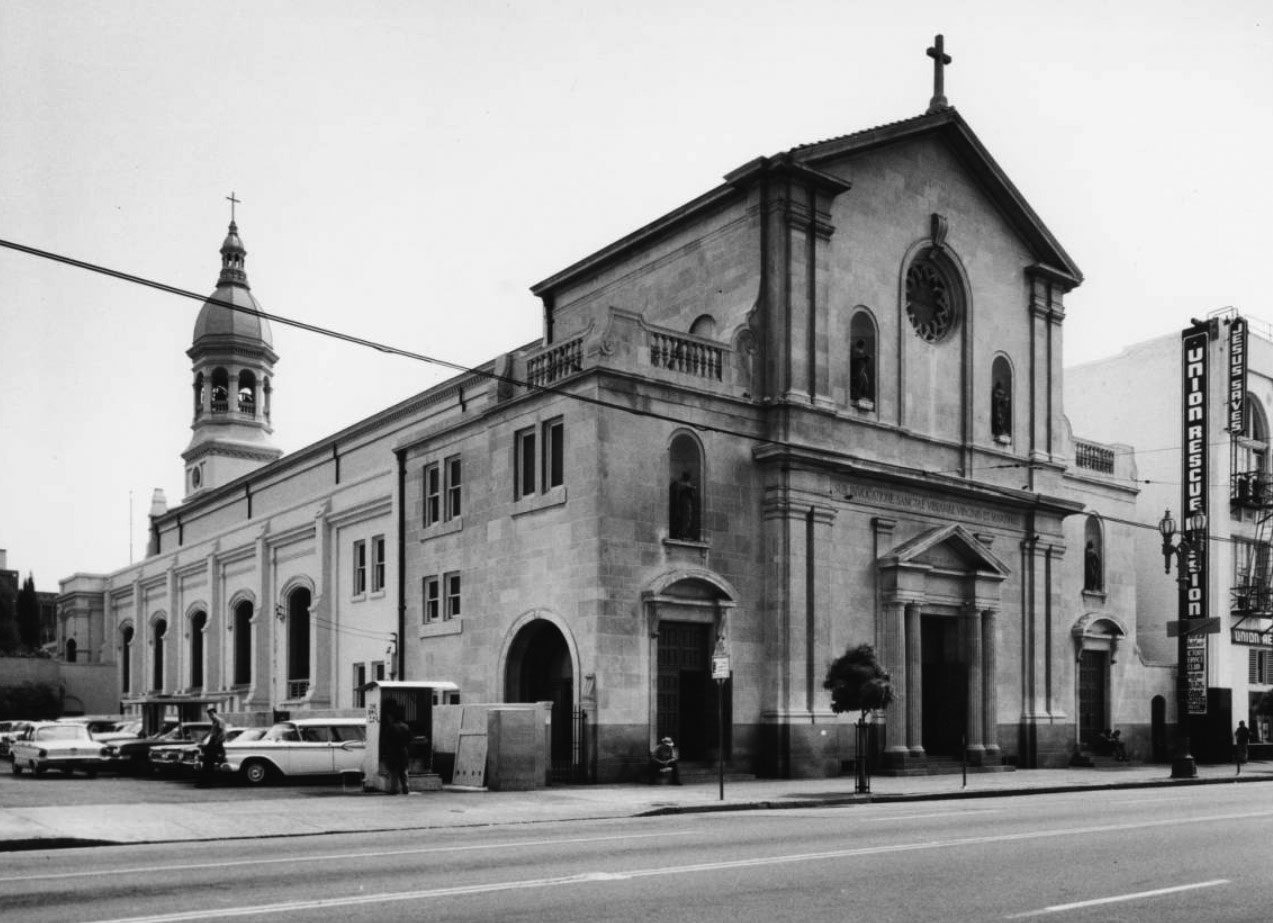 |
|
| (1960s)* - Exterior view of St. Vibiana's Cathedral showing a parking lot on the left side of the cathedral and the Union Rescue Mission on the right. |
Historical Notes The facade's classical pilasters and volutes are crowned with a tower and cupola. Inside are relics of an early Christian martyr whose name is given to the Cathedral, St. Vibiana. The remains are preserved in a marble sarcophagus.^ |
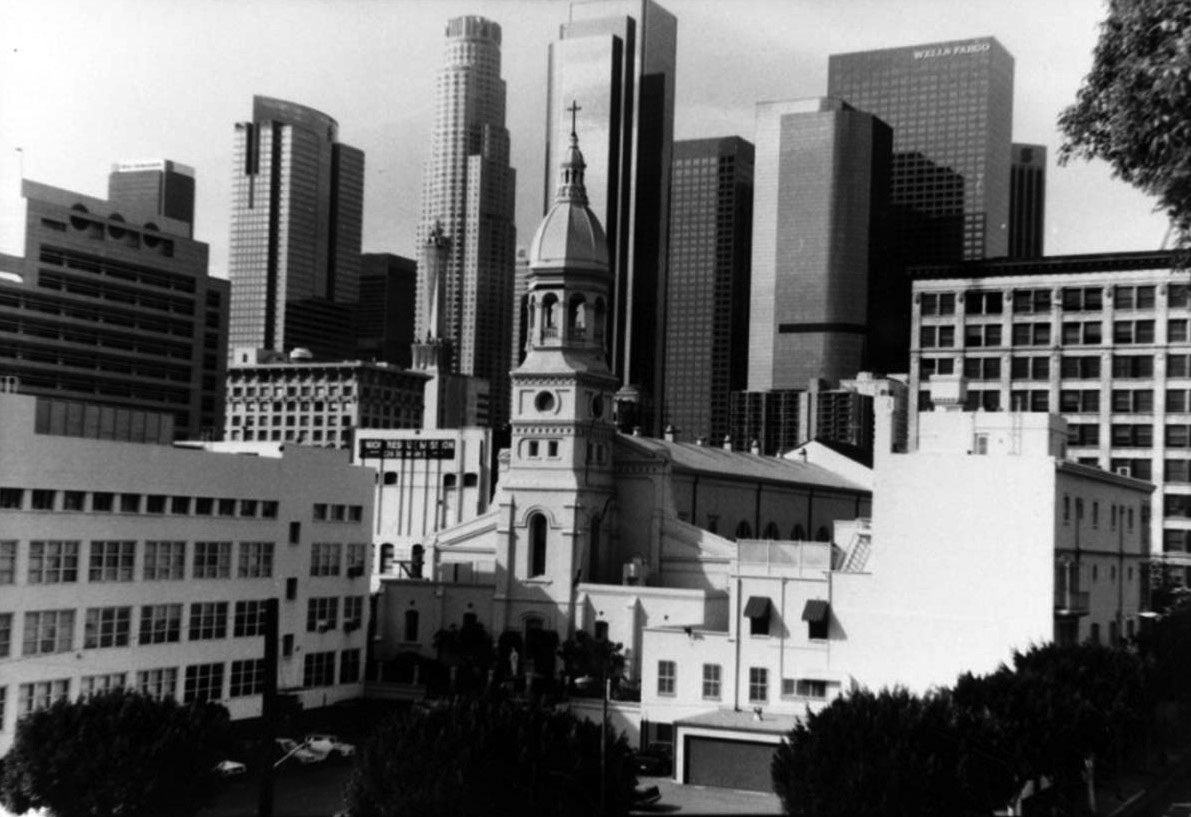 |
|
| (1995)* - View looking SW toward the back of the St. Vibiana’s Cathedral with the Downtown skyline in the background. |
Historical Notes In early 1996 the good Cardinal, who presides over the largest Catholic Diocese in the United States, proposed that it be torn down and replaced by a new Cathedral building. Preservation- and historic-minded L.A. folk protested loudly in response.^ |
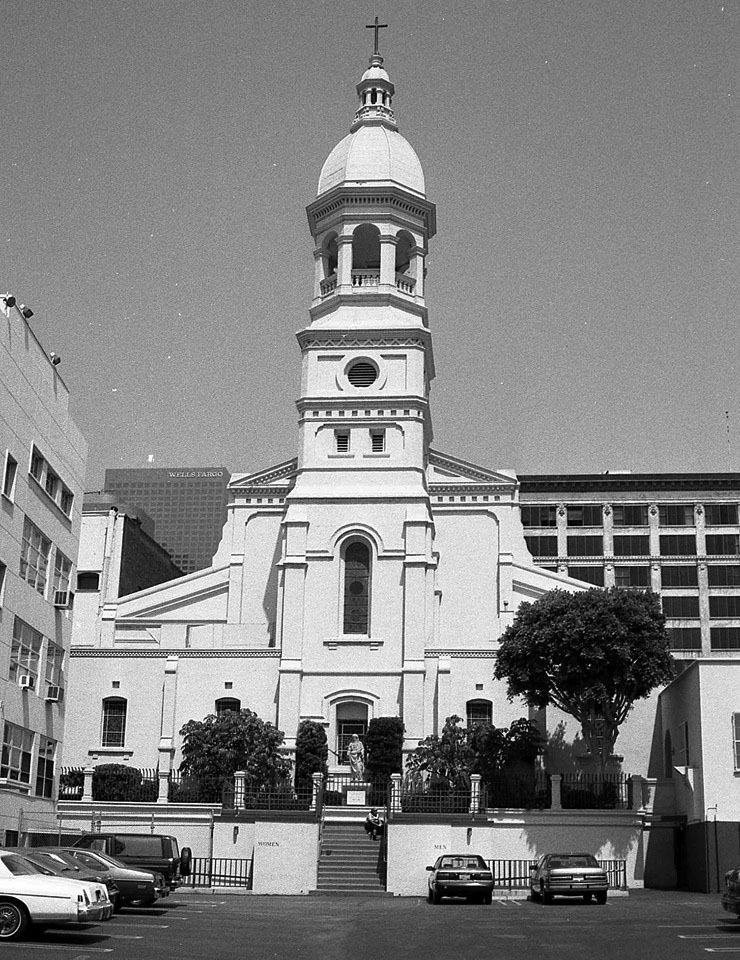 |
|
| (1990s)^ - View looking at St. Vibiana’s Cathedral from the East side. A view that no longer exists, as the parking lot was developed. Photo by Ray Long |
Historical Notes The cathedral was heavily damaged during the 1994 Northridge earthquake and became the subject of a lengthy legal battle between the archdiocese, which wanted to demolish the building and build a new cathedral on the site, and preservationists, who wanted the building to remain standing due to its historical significance. In 1996, the parties involved reached a compromise in which the archdiocese would purchase a nearby site on which to build a new cathedral, and in turn would turn over the St. Vibiana site to the City of Los Angeles. The Cathedral of Our Lady of the Angels was dedicated in 2002 as the successor to St. Vibiana's Cathedral.^ |
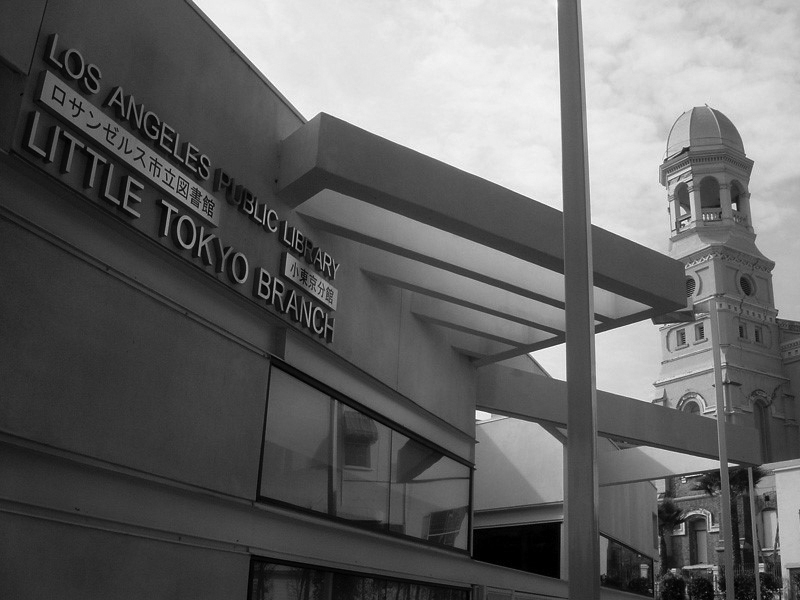 |
|
| (2006)* – View showing the St. Vibiana complex, which now includes the Little Tokyo Branch Library. |
Historical Notes The cathedral site was taken over by the city. The city sold the former cathedral building to downtown developer Tom Gilmore in 1999 for $4.6 million. The non-historic 1940s Education Building was demolished, making way for the new Little Tokyo Branch of the Los Angeles Public Library. The building celebrated the end of its renovation with a gala on November 12, 2005, though plans for its use were still undecided. In August 2007, the 3,500-pound cupola was returned to the top of the 83-foot tall bell tower.^ |
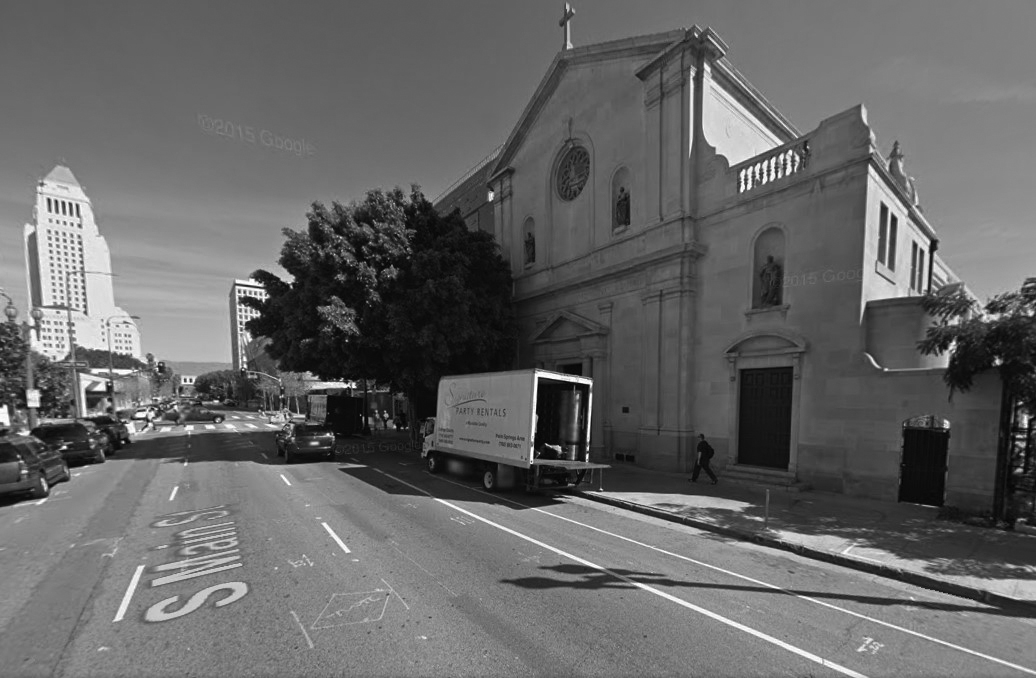 |
|
| (2015)* - View looking north on Main Street showing the old St. Vibiana's Cathedral building with City Hall in the background. |
Historical Notes The former cathedral building is now a performing arts complex and event venue called "Vibiana". The Little Tokyo branch of the Los Angeles Public Library is also located on the site.^ |
Then and Now
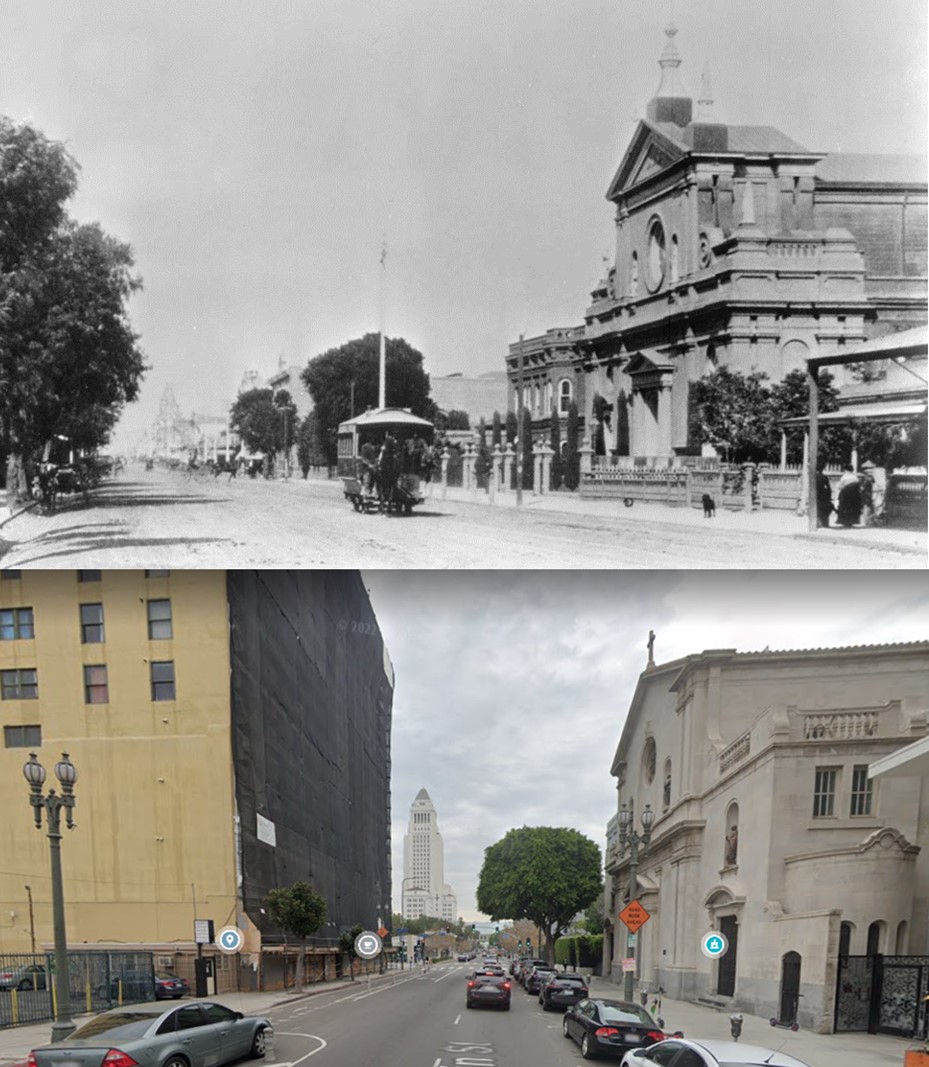 |
|
| (1884 vs. 2021)* – Looking north on Main Street toward 2nd Street showing the Cathedral of St. Vibiana building on the right. |
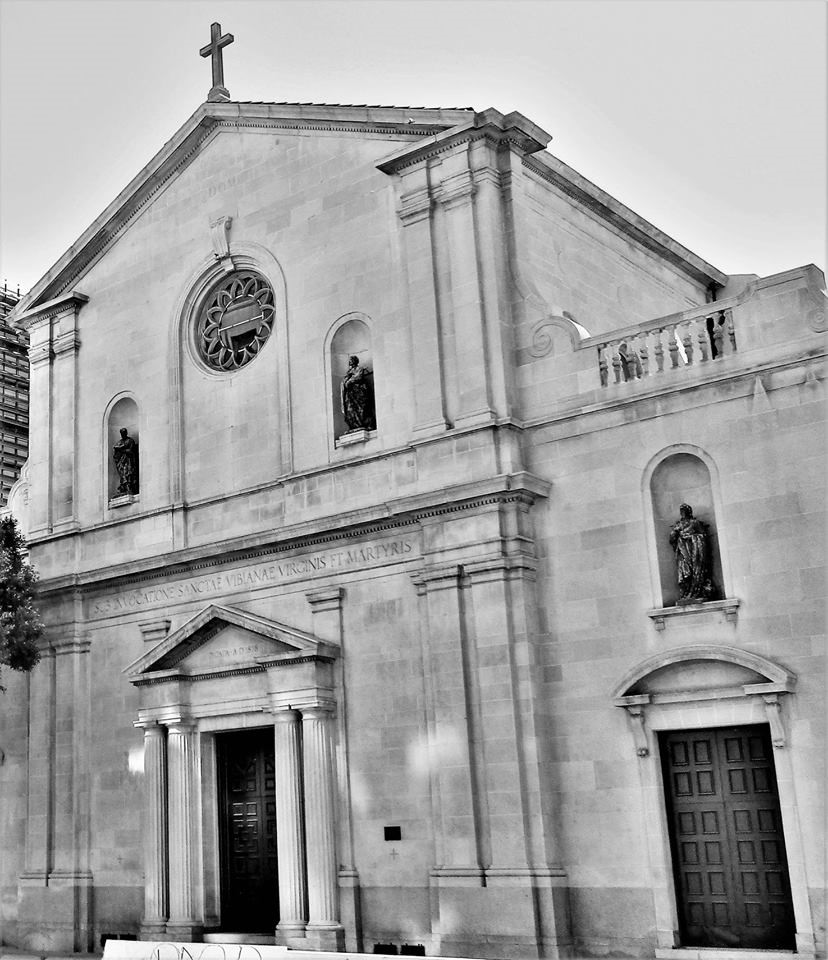 |
|
| (2018)^ - Close-up view of Main Street front side of the St Vibiana Church as it appears today. |
Historical Notes The late-1800s cathedral structure is one of the last remaining buildings from the early period of Los Angeles history. |
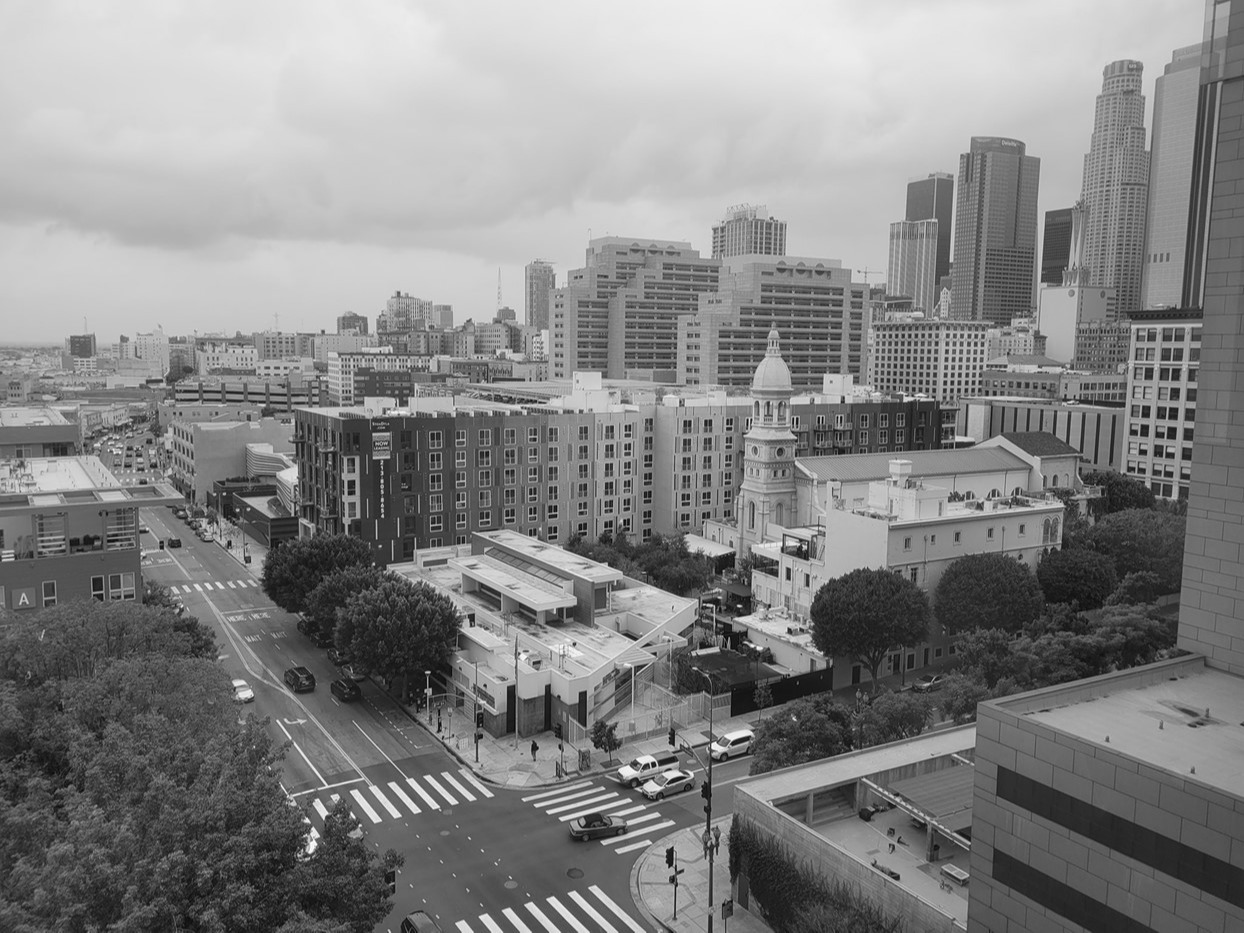 |
|
| (2022)* - Looking down at the intersection of 2nd and Los Angeles streets with St. Vibiana’s at center and the start of the downtown skyline at right. Photo courtesy of James J. Chun |
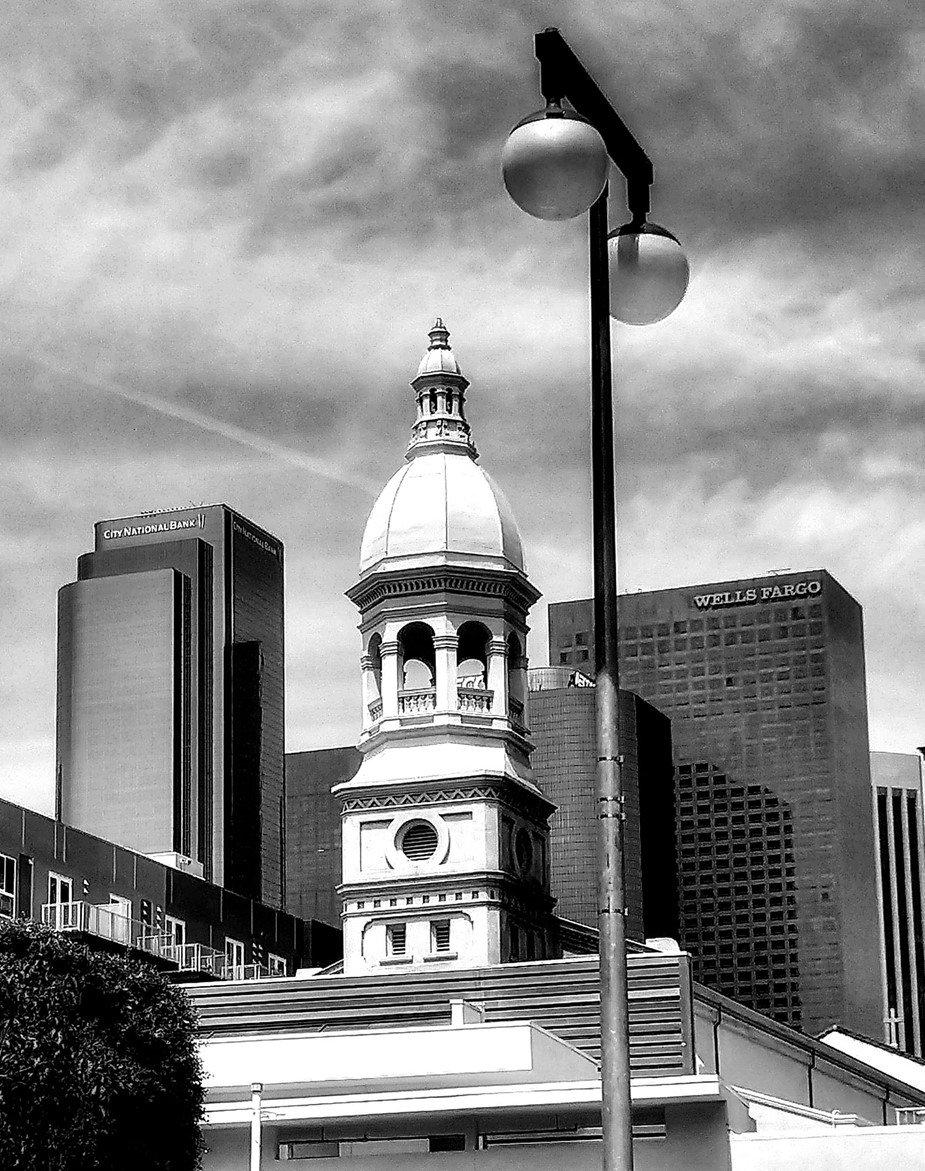 |
|
| (2018)*- The bell tower of St. Vibiana Church (now known as Redbird | Vibiana) with the downtown skyline in the background. Photo courtesy of Flo Selfman |
Historical Notes In 2017, the St. Vibiana Church structure was added to the National Trust for Historic Preservation list of America's Most Endangered Places "Success Stories"—sites that were named to the "Most Endangered" list that were the focus of successful preservation efforts. Amy Knoll Fraser and Chef Neal Fraser are now the owners and operators of Redbird | Vibiana, a wedding, events and performing arts venue located in the Historic Core of Downtown Los Angeles^. |
* * * * * |
|
Other Sections of Interest |
|
Water and Power in Early LA |
|
Newest Additions |
New Search Index |

A new SEARCH INDEX has been added to help navigate through the thousands of topics and images found in our collection. Try it out for a test run.
Click HERE for Search Index |
* * * * * |
< Back
Menu
- Home
- Mission
- Museum
- Major Efforts
- Recent Newsletters
- Historical Op Ed Pieces
- Board Officers and Directors
- Mulholland/McCarthy Service Awards
- Positions on Owens Valley and the City of Los Angeles Issues
- Legislative Positions on
Water Issues
- Legislative Positions on
Energy Issues
- Membership
- Contact Us
- Search Index
© Copyright Water and Power Associates
Layout by Rocket Website Templates